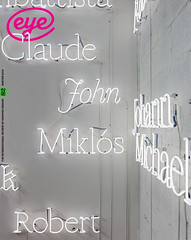Winter 2011
Telling it like it is
Typo London
Institute of Education, University of London <br>20-22 October 2011The long-running Typo Berlin conference brings together a thousand delegates under very expansive, and rather abstract, themes. It is not just a conference on type, although there is a good sprinkling of typography among the eclectic mix of presentations for design professionals who expect to be informed as much as entertained.
That FontShop sought to export the formula to other markets is not surprising. London, however, is a difficult location for conference organisers. Expensive accommodation limits the potential audience, and budgets are stretched by an abundance of competing events (the Typographic Circle, for example, kicked off its season during the keynote speech).
The gamble that a few hundred London-based designers would stump up £650 for a ticket paid off only in part: there were many students (helped by generous sponsorship from Xbox) crammed into the uninspiring Logan Hall. In a different environment the hour-long breaks (two hours for lunch) would have provided a great opportunity to mix and meet; here everybody was pushed out in the search for food or better coffee. All the more important, then, that the programme held its own.
Typo London’s theme was ‘Places’, woolly enough to allow an eclectic programme, with two strands and speakers including fine artists, film-makers, book designers, art directors and type designers. (Reports on individual presentations and links to blog posts can be found on typolondon.com.) Regardless of the nominal theme, however, the main focus of the conference was on design as storytelling, and an understanding of how people respond to a designed environment, be it architectural or virtual.
In some cases this notion connected directly with the presentation. Tim Fendley eschewed describing the process of making signs for Legible London, and focused on how people think about themselves in an urban environment. His talk showed how information design can be approached as a journey through a street plane at eye level, as a dialogue with architecture, and as a response to different emotional conditions (from the casual peregrinations of the tourist, to the hurried jog of the business person late for a meeting). He also explained how design connects with policy (the imperative to ‘get people off the Tube’) and empowerment (‘This is your vicinity, walk it’).
Several presenters talked about the importance of narrative in a project, and the idea of ‘the designer as curator’ rather than ‘the designer in dialogue with the reader’. If some of the more personal presentations made curation seem more like a collection of holiday snapshots, that should encourage designers to explain their selections, and be explicit with their interpretations.
Indeed, speakers representing the larger branding agencies (or, at least, the ones in Erik Spiekermann’s address book) were very much in tune with the idea of design being more than a marketing tool. Nat Hunter of Airside (since dissolved) and Marina Willer of Wolff Olins extended the idea of design as narration to its responsibility to engage with social issues. In this objective they were upstaged only by two speakers from the World Service: Kutlu Çanliŏglu and Titus Nemeth. The development of the BBC’s Global Experience Language and its Arabic webfont family was presented as a straightforward problem-solving exercise, but touched on matters of community empowerment, social inclusion, corporate responsibility, and a pragmatic but respectful attitude to users. This emphasis on internationalisation and typographic innovation in browsers and mobile devices for a global audience was repeated in the font track on Saturday, driving the point home that type is now a global enterprise.
At the other end of the scale, Tony Brook’s emotional talk about his obsession with Wim Crouwel was a highly enjoyable piece of soul-baring. It was sheer pleasure to encounter the sensitivity and enthusiasm that generated the Design Museum’s Crouwel retrospective in 2011 (see Eye 80).
Just as entertaining were Michael Bierut and Chip Kidd, both talking about the vortex of unpredictability that is The Client (Bierut deadpan and matter of fact, Kidd theatrical and in your face).
The most memorable soundbite belonged to another American, Pixar’s Michael B. Johnson, who talked about helping people to develop engaging, believable stories, and inventing new tools to help the animation process along. When he summarised Pixar’s approach as ‘quality is the best business plan’, you could see hundreds of heads nodding.
There is always a risk that speakers will show you what’s on their hard drive, and the hour-long slots didn’t help in this respect. But some of the most interesting discussions arose out of talks that were, superficially, about the past. Jonathan Barnbrook was the Thinking Designer with a Conscience, trying to make sense of an illogical, self-destructive world armed only with a pencil and a mouse – an example for the students in the audience.
And Neville Brody’s Fuse magazine retrospective was long overdue for a design audience that is increasingly removed from the intensive experimentation of the early years of digital typography (see Eye 15).
In the closing comments it was revealed that there will be another Typo London this year, 18-20 October, as well as a first conference in San Francisco.
There are lessons to be learned from 2011. Some shorter slots would allow the two tracks to be folded into one, eliminating the anxiety of the ‘better talk in the other hall’ without loss of substance. And, for the price, some decent coffee would be good.
Gerry Leonidas, senior lecturer, University of Reading
First published in Eye no. 82 vol. 20 2012
Eye is the world’s most beautiful and collectable graphic design journal, published quarterly for professional designers, students and anyone interested in critical, informed writing about graphic design and visual culture. It is available from all good design bookshops and online at the Eye shop, where you can buy subscriptions and single issues.

